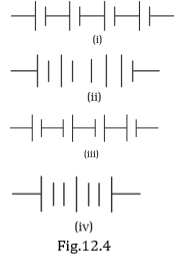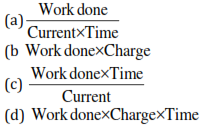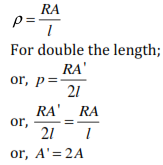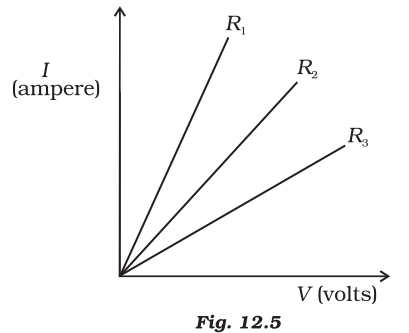NCERT Solution: Electricity
(a) The melting point and of Tungsten is an alloy which has very high melting point and very high resistivity so does not burn easily at a high temperature.
(b) The conductors of electric heating devices such as bread toasters and electric irons are made of alloy because resistivity of an alloy is more than that of metals which produces large amount of heat.
(c) In series circuits voltage is divided. Each component of a series circuit receives a small voltage so the amount of current decreases and the device becomes hot and does not work properly. Hence, series arrangement is not used in domestic circuits.
(d) Resistance (R) of a wire is inversely proportional to its area of cross-section (A), i.e. when area of cross section increases the resistance decreases or vice versa.
R α 1/A
(e) Copper and aluminium are good conductors of electricity also they have low resistivity. So they are usually used for electricity transmission.
1. A cell, a resistor, a key and ammeter are arranged as shown in the circuit
diagrams of figure12.1. The current recorded in the ammeter will be
(a) maximum in (i)
(b) maximum in (ii)
(c) maximum in (iii)
(d) the same in all the cases
Ans. (d) The same in all the cases
Explanation: None of the conditions change in any of the circuits. Hence,
current would be same in all circuits.
2. In the following circuits (Figure 12.2), heat produced in the resistor or
combination of resistors connected to a 12 V battery will be
(a) same in all the cases
(b) minimum in case (i)
(c) maximum in case (ii)
(d) maximum in case (iii)
Ans. (c) Maximum in case (ii)
Explanation: In this case, two resistors are in series. Hence, their sum will be
equal to their arithmetic sum. In figure (iii) the total resistance will be less
than individual resistances because they are connected in parallel. A higher
resistance produces more heat so option (c) is correct.
3. Electrical resistivity of a given metallic wire depends upon
(a) its length
(b) its thickness
(c) its shape
(d) nature of the material
Ans. (d) Nature of the material
4. A current of 1 A is drawn by a filament of an electric bulb. Number of
electrons passing through a cross section of the filament in 16 seconds would be
roughly
(a) 1020
(b) 1016
(c) 1018
(d) 1023
ans A
Explanation: We have current I=1 A and time t=16s
We know;
I = Q / t or 1 A = Q/ 16 s
Q= 16C
Charge contained in 1 electron 1.6 x 10-19 C
So, 16 C charge is contained in following number of electrons;
![]()
5. Identify the circuit (Figure 12.3) in which the electrical components have
been properly connected.
(a) (i)
(b) (ii)
(c) (iii)
(d) (iv)
Ans. (b) (ii)
6. What is the maximum resistance which can be made using five resistors each of
1/5 Ω?
(a) 1/5 Ω
(b) 10 Ω
(c) 5 Ω
(d) 1 Ω
Ans. (d) 1Ω
7. What is the minimum resistance which can be made using five resistors each of
1/5 Ω ?
(a) 1/5 Ω
(b) 1/25 Ω
(c) 1/10 Ω
(d) 25 Ω
Ans. (b) 1/25 Ω
Explanation: When resistors are connected in parallel then we get the minimum
resistance out of the combination.
When given resistors are connected in parallel, the resistance of combination
can be calculated as follows:

8. The proper representation of series combination of cells (Figure12.4)
obtaining maximum potential is

(a) (i)
(b) (ii)
(c) (iii)
(d) (iv)
Ans. (a) (i)
Explanation: In this combination, positive terminal of next cell is adjacent to
negative terminal of previous cell.
9. Which of the following represents voltage?

Ans a
10. A cylindrical conductor of length l and uniform area of cross section A has
resistance R. Another conductor of length 2l and resistance R of the same
material has area of cross section
(a) A/2
(b) 3A/2
(c) 2A
(d) 3A
Ans. (c) 2A
Explanation: Both the conductors are of same material hence their resistivity is
same.

11. A student carries out an experiment and plots the V-I graph of three samples
of nichrome wire with resistances R1 R2 and R3 respectively (Figure. 12.5).
Which of the following is true?

(a) R1= R2= R3
(b) R1> R2 > R3
(c) R1> R2> R3
(d) R1 > R2 > R3
ANS C
Explanation: Current is inversely proportional to resistance. So, higher
resistance would allow less current to pass; which is shown by resistance R3.
12. If the current I through a resistor is increased by 100% (assume that
temperature remains unchanged), the increase in power dissipated will be
(a) 100 %
(b) 200 %
(c) 300 %
(d) 400 %
Ans. (c) 300 %
Explanation: The heat generated by a resistor is directly proportional to square
of current. Hence, when current becomes double, dissipation of heat will
multiply by 22 =4. This means there will be an increase of 300%.
13. The resistivity does not change if
(a) the material is changed
(b) the temperature is changed
(c) the shape of the resistor is changed
(d) both material and temperature are changed
Ans. (c) the shape of the resistor is changed
14. In an electrical circuit three incandescent bulbs A, B and C of rating 40 W,
60 W and 100 W respectively are connected in parallel to an electric source.
Which of the following is likely to happen regarding their brightness?
(a) Brightness of all the bulbs will be the same
(b) Brightness of bulb A will be the maximum
(c) Brightness of bulb B will be more than that of A
(d) Brightness of bulb C will be less than that of B
Ans. (c) Brightness of bulb B will be more than that of A
Explanation: Since bulbs are connected in parallel so resistance of combination
would be less than arithmetic sum of resistance of all the bulbs. So, there will
be no negative effect on flow of current. As a result, bulbs would glow
according to their wattage.
15. In an electrical circuit two resistors of 2 O and 4 O respectively are
connected in series to a 6 V battery. The heat dissipated by the 4 O resistor in
5 s will be
(a) 5 J
(b) 10 J
(c) 20 J
(d) 30 J
Ans. (c) 20 J
Explanation: Total resistance of combination =2 Ω + 4 Ω = 6Ω
Current through the circuit can be calculated as follows:
I = V / R
= 1A
Heat dissipation by 4Ω can be calculated as follows:
H = I2 RT = (IA)2 x 4Ω x 5s = 20 J
16. An electric kettle consumes 1 kW of electric power when operated at 220 V. A
fuse wire of what rating must be used for it?
(a) 1 A
(b) 2 A
(c) 4 A
(d) 5 A
Ans. (d) 5 A
Explanation: Power=1 kW= 1000W
Current flowing through the kettle can be calculated as follows:
P = V x I
Or 1000W = 220 V x I
Or I = 1000w / 220V = 4.24A
So, required rating of fuse wire=5A
17. Two resistors of resistance 2 Ω and 4 Ω when connected to a battery will
have
(a) same current flowing through them when connected in parallel
(b) same current flowing through them when connected in series
(c) same potential difference across them when connected in series
(d) different potential difference across them when connected in parallel
Ans. (b) same current flowing through them when connected in series.
Explanation: In series combination, current does not change because each
resistor receives a common current. In other words, current does not get divided
into branches.
18. Unit of electric power may also be expressed as
(a) volt ampere
(b) kilowatt hour
(c) watt second
(d) joule second
Ans. (b) kilowatt hour
A child has drawn the electric circuit to study Ohm�s law as shown in Figure
12.6. His teacher told that the circuit diagram needs correction. Study the
circuit diagram and redraw it after making all corrections.
ANS
Correct diagram is as follows:
Three 2 Ω resistors, A, B and C, are connected as shown in Figure 12.7. Each of them dissipates energy and can withstand a maximum power of 18 W without melting. Find the maximum current that can flow through the three resistors?
Current can be calculated as follows:
P =I2R
or, 18W = I2× 2Ω
I2 = 18W / 2Ω = 9
or I = 3A
Resistance of ammeter should ideally be zero so that ammeter should not affect the flow of current in circuit. Hence, resistance of an ammeter should be very low because zero resistance is not possible in real life.
Total resistance for parallel combination of 4Ω resistors can be calculated as follows:
1/ R = 1/4 + 1/4 =1/2 or R = 2Ω
Thus, resistance of parallel combination is equal to resistance of resistors in series. So, potential difference across 2Ω resistance will be same as potential difference across the other two resistors which are connected in parallel.
Fuse wire has low resistance than current rating of the main wiring. So, whenever there is a surge in electric current, the fuse wire melts and breaks the circuit. This prevents any damage to the electrical appliances. Thus, a fuse wire protects electrical appliances.